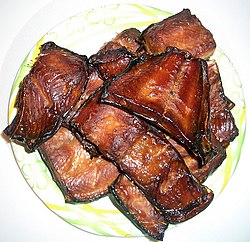
Back تدخين (طبخ) Arabic Selchn BAR Tinapa BCL Вэнджанне Byelorussian Опушване Bulgarian Fumatge Catalan Uzení Czech Wãdzenié CSB Räuchern German Κάπνισμα τροφίμων Greek



Hot-smoked chum salmon
Smoking is the process of flavoring, browning, cooking, or preserving food, particularly meat, fish and tea, by exposing it to smoke from burning or smoldering material, most often wood.
In Europe, alder is the traditional smoking wood, but oak is more often used now, and beech to a lesser extent.[clarification needed] In North America, hickory, mesquite, oak, pecan, alder, maple, and fruit tree woods, such as apple, cherry, and plum, are commonly used for smoking. Other biomass besides wood can also be employed, sometimes with the addition of flavoring ingredients. Chinese tea-smoking uses a mixture of uncooked rice, sugar, and tea, heated at the base of a wok.
Some North American ham and bacon makers smoke their products over burning corncobs. Peat is burned to dry and smoke the barley malt used to make Scotch whisky and some beers. In New Zealand, sawdust from the native manuka (tea tree) is commonly used for hot-smoking fish. In Iceland, dried sheep dung is used to cold-smoke fish, lamb, mutton, and whale.
Historically, farms in the Western world included a small building termed the "smokehouse", where meats could be smoked and stored. This was generally well separated from other buildings both because of fire danger and smoke emanations. The smoking of food may possibly introduce polycyclic aromatic hydrocarbons, which may lead to an increased risk of some types of cancer; however, this association is still being debated.[1][2][3][4][5][disputed – discuss]
Smoking can be done in four ways: cold smoking, warm smoking, hot smoking, and through the employment of a smoke flavoring, such as liquid smoke.[6] However, these methods of imparting smoke only affect the food surface, and are unable to preserve food, thus, smoking is paired with other microbial hurdles, such as chilling and packaging, to extend food shelf-life.[6]
- ^ Fritz, W.; Soós, K. (1980). "Smoked food and cancer". Bibliotheca Nutritio et Dieta. Forum of Nutrition. 29 (29): 57–64. doi:10.1159/000387467. ISBN 978-3-8055-0621-2. ISSN 0067-8198. PMID 7447916.
- ^ Steck, Susan E.; Gaudet, Mia M.; Eng, Sybil M.; Britton, Julie A.; Teitelbaum, Susan L.; Neugut, Alfred I.; Santella, Regina M.; Gammon, Marilie D. (May 2007). "Cooked meat and risk of breast cancer--lifetime versus recent dietary intake". Epidemiology. 18 (3): 373–382. doi:10.1097/01.ede.0000259968.11151.06. ISSN 1044-3983. PMID 17435448. S2CID 31296606.
- ^ Forsberg, Norman D.; Stone, Dave; Harding, Anna; Harper, Barbara; Harris, Stuart; Matzke, Melissa M.; Cardenas, Andres; Waters, Katrina M.; Anderson, Kim A. (July 11, 2012). "Effect of Native American fish smoking methods on dietary exposure to polycyclic aromatic hydrocarbons and possible risks to human health". Journal of Agricultural and Food Chemistry. 60 (27): 6899–6906. Bibcode:2012JAFC...60.6899F. doi:10.1021/jf300978m. ISSN 1520-5118. PMC 3567306. PMID 22690788.
- ^ Li, Jiafu; Dong, Han; Li, Xianguo; Han, Bin; Zhu, Chenjian; Zhang, Dahai (February 2016). "Quantitatively assessing the health risk of exposure to PAHs from intake of smoked meats". Ecotoxicology and Environmental Safety. 124: 91–95. Bibcode:2016EcoES.124...91L. doi:10.1016/j.ecoenv.2015.10.007. ISSN 1090-2414. PMID 26476877.
- ^ Rozentale, Irina; Zacs, Dzintars; Bartkiene, Elena; Bartkevics, Vadims (June 2018). "Polycyclic aromatic hydrocarbons in traditionally smoked meat products from the Baltic states". Food Additives & Contaminants. Part B, Surveillance. 11 (2): 138–145. doi:10.1080/19393210.2018.1440637. ISSN 1939-3229. PMID 29486658. S2CID 4278573.
- ^ a b Fellows, P. (2017). Food processing technology : principles and practice (4th ed.). Kent: Woodhead Publishing/Elsevier Science. ISBN 978-0-08-101907-8. OCLC 960758611.